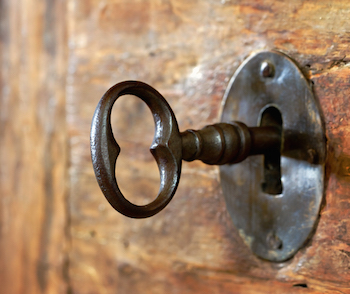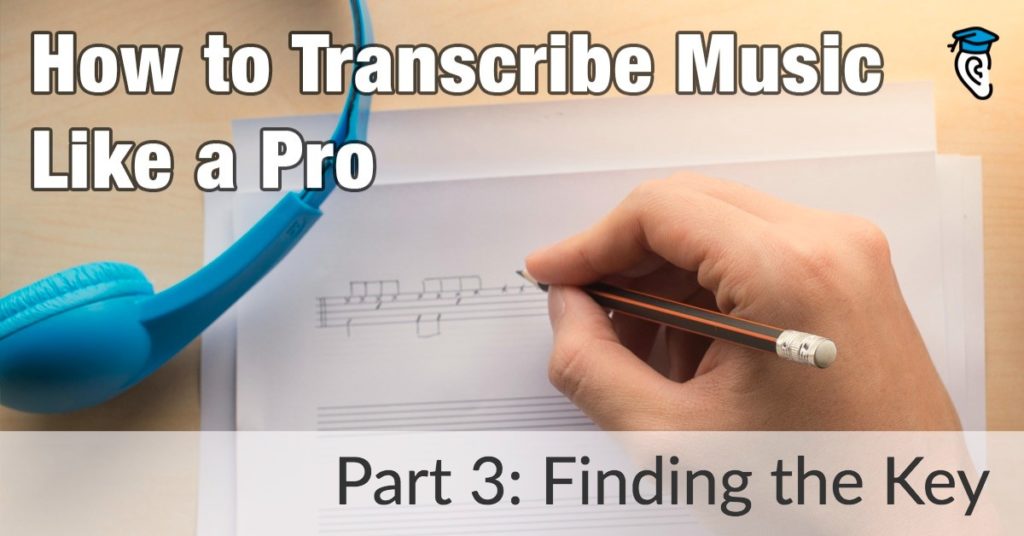You hear your favorite tune on Pandora and want to jam along, but every note you play seems to be wrong, even if the melody somehow sounds right at the same time. What could be the problem? Chances are you are playing in the wrong key.
When you transcribe a song, finding the key of the tune is the vital step to quickly figuring out the notes. Finding the key is always recommended, unless you only need the drum part: the only key we drummers use is when we are rocking out like a crazed monkey!
Yeah, okay, enough of the bad jokes…
By now you should be armed with a basic drum transcription providing you with a framework for the rest of your transcribing task. Now read on to find out how to figure out the musical key of a song by ear.
What is the Musical Key?
If you have ever looked at sheet music or a lead sheet, you will notice that a series of letters from A to G are used. As well as being used for individual notes these can also correspond to chords (groups of notes played together) and the key: the full set of notes which the song is built from.
A key consists of two parts:
- A letter name (the “tonic” note) and
- The quality (whether the key is major or minor.
Loosely speaking, the musical key corresponds to the musical scale (e.g. “C Major” or “A Minor”) which the notes of the song are drawn from.
Watch this video from Dave Conservatoire for more on key:
Finding the key from the chords
Here’s a handy shortcut. In most standard popular tunes, the chord you see the most on the lead sheet is also the key of the piece. It is probably also the first and/or last chord of the piece.
The example below is in the key of C Major, and as you can tell, the first and last chords are also C Major chords:

When you transcribe, you won’t always have a lead sheet available to help, but it does help to keep the “lead sheet” concept in mind when transcribing. It lets you take some shortcuts.
For example, many songs follow some sort of I–V–I progression, which means that if a song is in the key of F, then you will most likely be using a lot of F chords (I) and C chords (V). We’ll cover this in more detail when we discuss transcribing harmony but it should help you start to see why it is important to find the scale of a song.
Finding the Key: Easy as 1-2-3
When you are figuring out the key of a piece, the easiest way to do this is to follow these three steps:
- Play a section of the song several times and listen carefully
- Sing or pick out notes by ear that seem to sound the best with the song
- Check your notes by building full chords from them
1. Play a section of the song several times and listen carefully
When you are listening to a song for transcription, it sometimes helps to just loop a single section over and over again. You can do this in a free program like Audacity, a DAW like Garageband or Protools, or use special transcription software. Learn more about these options in part one of this series.
Don’t worry too much about the technology, just use what you have available.
Looping the audio allows you to focus on a single section over and over again. In most cases, looping the introduction alone will give you the key of song, since that is where the songwriter will establish the harmonic basis for the rest of the song.
2. Sing or pick out notes by ear that seem to sound the best with the song
 This is a simple trial and error process, relying on your ear training skills and sense of consonance and dissonance.
This is a simple trial and error process, relying on your ear training skills and sense of consonance and dissonance.
All your relative pitch skills (intervals, scales, chords, progressions, etc.) will come in handy here but even if you haven’t formally trained your ears at all, you probably already have a good instinct for which notes sound “wrong” or “out of tune” with a song.
3. Check your notes by building full chords from them
Sometimes a note fits with a section of a song but isn’t actually the main note and won’t directly reveal the key of the song. One thing you can do to check you’ve found the right note is to try playing the full chord built on that note, i.e. your guess at the tonic chord.
Start with the major triad chord since major chords are more common in mainstream music than minor chords. If it doesn’t sound right, try the minor chord instead. If one of those works, you’ve probably now identified the tonic and the quality of the key: you’ve got it!
If neither works, you’ve probably found a note which features in the chords and the key, but isn’t actually the tonic. Keep looking!
Pro Tip: Try the other notes of chords which feature the note you found. For example, if G sounded right but G Major and G Minor chords didn’t, try other chords which feature a G, such as C Major or E Minor.
Key-Finding Example
In this example, the beginning of the sample instrumental is played and a piano is “guessing” the correct scale.
First the piano plays G, then C# [0:08], then C [0:12], and then F [0:15]. Then the pianist starts playing the F Major Chord [0:31] at the beginning of the section, demonstrating that this chord fits the song, which is in F Major.
- As you listen, which notes sound correct? Which don’t?
- What notes could be in the correct scale but just not be in the correct key?
- Can you hear how the F Major chords sound consonant compared to the dissonance of the C# note earlier?
Keep in mind that with chord changes some notes will sound more accurate than others. The point isn’t to find the one perfect chord that works throughout the section, but to find the single note that sounds the most accurate the most times and seems to occur whenever the repeated section begins.
In the example above, the C# sounded the worst, or the most dissonant, because it is not in the key of F Major at all. Both C and G are in the key of F Major. C is the first note of the C Major Chord, which is the Dominant chord of the F Major Scale, meaning that it will be used very often. That is why it is good to play notes over and over and check with chords. Sometimes you might find other chords in the right key. Don’t let these mislead you to the wrong key, but keep them in mind as you can use them to help with your transcription.
Now play the full instrumental example, looping the introduction and other key parts in playback. Try different notes and chords. You already know that this example is in F Major, but try playing the wrong notes on purpose to train your ear to hear what is correct and what is incorrect!
What is a Key Change?
Many songs include a key change of some sort. This means that the song moves from one scale to another, usually a related one, for example C to G (not sure why those are related? Check the Circle of Fifths!) or even up a step like A♭ to A.
You will often find key changes at the bridge, the final chorus, or where the songwriter wanted to make a musical impact through a change in harmony. Sometimes this is a big obvious change, and you will quickly learn to recognise these “truck driver gear shifts” immediately. Some can be more subtle, so just keep in mind that if it seems like one part of the song features very different notes and chords to the rest, there may be a key change in the transition.
What to do when transcribing? It’s simple: if you have a section which features a key change, just loop its two parts separately and follow the simple method above again.
Practice Finding the Key
Below are two examples for practice. Remember, for each example:
- Play the section of the song several times and listen carefully
- Sing or pick out notes by ear that seem to sound the best with the song
- Check your notes by building full chords from them
Show answer
Show answer
The Key to Easy Transcription
Finding the key of a song will help you greatly as you transcribe. It gives you a clear roadmap to follow as you figure out more difficult components like melody and harmony.
To develop your key-finding skills you can practice figuring out the scales to your favorite tunes on the radio, in films, or even video game soundtracks.
Remember to check your answer by playing the corresponding scale and seeing if the notes mostly sound consonant. Hey, you’re one step closer to transcribing the melody! Or, take it a step further and try playing the other chords which belong to the key. Now you’re taking your first steps to transcribing the chord progression and harmony!
Giveaway Contest!
As mentioned in the first part of this series, Anytune is a fantastic tool to help you transcribe music more easily.
The team behind this excellent software have kindly provided some prizes to accompany our new series, How to Transcribe Music like a Pro.
- To unlock the Pro features of the Anytune iOS app simply follow along with this series and collect the letters of the special unlock code. Then follow the instructions here to redeem the code.
Your third pair of letters: _ _ _ I _ _ _ _ _ _ _ _ S
Look out for the next parts of this series to pick up more letters! - We also have 6 copies of Anytune Mac to give away. For a chance of winning, post a comment on our Facebook page here before the series ends. We’ll pick 6 random entrants to win on August 30th!
Our thanks to Anytune for providing these prizes. And good luck!








